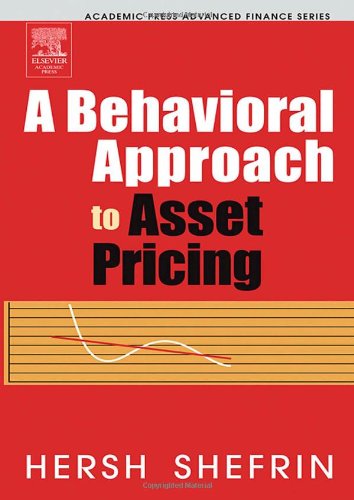Hersh Shefrin0126393710, 9780126393712, 9781423708223, 0120887835
Table of contents :
1 Introduction……Page 26
1.1.1 Value to Proponents of Traditional Asset Pricing……Page 27
1.1.2 Value to Proponents of Behavioral Asset Pricing……Page 30
1.2 Organization: How the Ideas in This Book Tie Together……Page 31
1.2.3 Developing Behavioral Asset Pricing Models……Page 32
1.2.4 Heterogeneity in Risk Tolerance and Time Discounting……Page 33
1.2.6 Applications of Behavioral SDF……Page 34
1.2.7 Prospect Theory……Page 36
1.3 Summary……Page 37
Part I Heuristics and Representativeness: Experimental Evidence……Page 38
2 Representativeness and Bayes Rule: Psychological Perspective……Page 40
2.3 Experiment……Page 41
2.3.1 Three Groups……Page 42
2.3.3 Results……Page 43
2.4 Representativeness and Prediction……Page 44
2.4.1 Two Extreme Cases……Page 45
2.4.4 Strength of Relationship Between Signal and Prediction……Page 46
2.4.5 How Regressive?……Page 47
2.5 Summary……Page 48
3.1.1 Design……Page 50
3.1.2 Experimental Task: Bayesian Approach……Page 51
3.3 Results……Page 53
3.3.1 Underweighting Base Rate Information……Page 56
3.4 Summary……Page 57
4 A Simple Asset Pricing Model Featuring Representativeness……Page 58
4.2 Expected Utility Model……Page 59
4.3 Equilibrium Prices……Page 62
4.4 Representativeness……Page 63
4.5 Second Stage: Signal-Based Market Structure……Page 64
4.6 Summary……Page 66
5.1 Grether Experiment……Page 68
5.2 Heterogeneity in Predictions of GPA……Page 69
5.3.1 Forecasts of the S&P Index: Original Study……Page 71
5.3.2 Replication of De Bondt Study……Page 77
5.3.3 Overconfidence……Page 79
5.4 Why Some Bet on Trends and Others Commit Gambler’s Fallacy……Page 80
5.5 Summary……Page 82
Part II Heuristics and Representativeness: Investor Expectations……Page 84
6.1 Individual Investors……Page 86
6.1.1 Bullish Sentiment and Heterogeneity……Page 87
6.1.3 Heterogeneous Beliefs……Page 88
6.1.4 Trend Following……Page 89
6.1.5 The Impact of Demographic Variables……Page 91
6.1.6 Own Experience: Availability Bias……Page 92
6.1.7 Do Individual Investors Bet on Trends? Perceptions and Reactions to Mispricing……Page 93
6.2 The Expectations of Academic Economists……Page 94
6.2.1 Heterogeneous Beliefs……Page 95
6.2.2 Welch’s 1999 and 2001 Surveys……Page 97
6.3 Financial Executives……Page 98
6.4 Summary……Page 99
7.1 Contrasting Predictions: How Valid?……Page 100
7.2 Update to Livingston Survey……Page 101
7.2.1 Heterogeneity……Page 102
7.3 Individual Forecasting Records……Page 105
7.3.1 Frank Cappiello……Page 107
7.3.2 Ralph Acampora……Page 111
7.4 Gambler’s Fallacy……Page 113
7.4.1 Forecast Accuracy……Page 114
7.4.2 Excessive Pessimism……Page 115
7.4.3 Predictions of Volatility……Page 116
7.5 Why Heterogeneity Is Time Varying……Page 118
7.6 Summary……Page 119
Part III Developing Behavioral Asset Pricing Models……Page 122
8.1 A Simple Model with Two Investors……Page 124
8.1.3 State Prices……Page 125
8.1.5 Expected Utility Maximization……Page 126
8.2 Equilibrium Prices……Page 127
8.2.1 Formal Argument……Page 128
8.3 Fixed Optimism and Pessimism……Page 129
8.4 Incorporating Representativeness……Page 132
8.5 Summary……Page 134
9.1 Defining Market Efficiency……Page 136
9.1.2 Risky Arbitrage……Page 138
9.1.4 When Π Is Nonexistent……Page 139
9.2.1 Example of Market Inefficiency……Page 140
9.3 Equilibrium Prices as Aggregators……Page 141
9.4 Market Efficiency: Necessary and Su.cient Condition……Page 142
9.5.1 When the Market Is Naturally Efficient……Page 144
9.5.3 When the Market Is Naturally Inefficient……Page 145
9.6 Summary……Page 147
10.1.1 Expected Utility Maximization……Page 148
10.2.1 Market Portfolio……Page 151
10.3 Analysis of Trading Volume……Page 152
10.3.1 Theory……Page 154
10.4.1 Stochastic Processes……Page 156
10.4.2 Available Securities……Page 158
10.4.4 Equilibrium Portfolio Strategies……Page 159
10.4.5 Markov Structure, Continuation, and Asymmetric Volatility……Page 162
10.5.1 State Prices……Page 164
10.6 Summary……Page 165
11 Efficiency and Entropy: Long-Run Dynamics……Page 166
11.1 Introductory Example……Page 167
11.1.1 The Market……Page 168
11.1.3 Portfolio Relationships……Page 169
11.1.4 Wealth Share Equations……Page 170
11.2 Entropy……Page 172
11.3 Numerical Illustration……Page 173
11.4 Markov Beliefs……Page 174
11.5 Heterogeneous Time Preference, Entropy, and Efficiency……Page 175
11.5.1 Modeling Heterogeneous Rates of Time Preference……Page 176
11.5.2 Market Portfolio……Page 177
11.5.3 Digression: Hyperbolic Discounting……Page 178
11.6 Entropy and Market E.ciency……Page 179
11.7 Summary……Page 182
Part IV Heterogeneity in Risk Tolerance and Time Discounting……Page 184
12.1 Arrow–Pratt Measure……Page 186
12.3 Constant Relative Risk Aversion……Page 187
12.3.2 Risk Premia……Page 188
12.4.1 Risk Premium in a Discrete Gamble……Page 189
12.5 CRRA Demand Function……Page 190
12.6 Representative Investor……Page 191
12.7 Example……Page 192
12.7.1 Aggregation and Exponentiation……Page 194
12.8 CARA Utility……Page 195
12.9 Summary……Page 199
13.1.1 Questions to Elicit Relative Risk Aversion……Page 200
13.1.2 Two Waves……Page 202
13.1.3 Status Quo Bias……Page 203
13.2 Extended Survey……Page 204
13.3 Time Preference……Page 207
13.4 Summary……Page 208
14 Representative Investors in a Heterogeneous CRRA Model……Page 210
14.1 Relationship to Representative Investor Literature……Page 211
14.1.1 Additional Literature……Page 213
14.2 Modeling Preliminaries……Page 214
14.3 Efficient Prices……Page 215
14.4 Representative Investor Characterization Theorem……Page 216
14.4.1 Discussion……Page 219
14.5 Comparison Example……Page 220
14.6.1 Argument Claiming that Theorem 14.1 Is False……Page 223
14.6.2 Identifying the Flaw……Page 224
14.7 Summary……Page 225
Part V Sentiment and Behavioral SDF……Page 226
15.1 Intuition: Kahneman’s Perspective……Page 228
15.1.1 Relationship to Theorem 14.1……Page 229
15.2 Sentiment……Page 231
15.3 Example Featuring Heterogeneous Risk Tolerance……Page 232
15.4.1 Representativeness: Errors in First Moments……Page 234
15.4.2 Overconfidence: Errors in Second Moments……Page 237
15.4.3 Link to Empirical Evidence……Page 240
15.4.4 Evidence of Clustering……Page 241
15.5 Sentiment as a Stochastic Process……Page 243
15.6 Summary……Page 244
16 Behavioral SDF and the Sentiment Premium……Page 246
16.1 The SDF……Page 247
16.2 Sentiment and the SDF……Page 248
16.2.1 Example……Page 249
16.3.1 Pitfall: The Behavioral Framework Admits a Traditional SDF……Page 251
16.3.2 Pitfall: Heterogeneity Need Not Imply Sentiment……Page 252
16.3.3 Pitfall: Heterogeneity in Risk Tolerance Is Sufficient to Explain Asset Pricing……Page 253
16.4 Sentiment and Expected Returns……Page 255
16.4.1 Interpretation and Discussion……Page 257
16.4.2 Example Illustrating Theorem 16.2……Page 258
16.5 Entropy and Long-Run Efficiency……Page 259
16.5.1 Formal Argument……Page 260
16.6 Learning: Bayesian and Non-Bayesian……Page 261
16.7 Summary……Page 262
Part VI Applications of Behavioral SDF……Page 264
17.1 Mean-Variance Efficiency and Market Efficiency……Page 266
17.2 Characterizing Mean-variance Efficient Portfolios……Page 267
17.3 The Shape of Mean-Variance Returns……Page 269
17.4 The Market Portfolio……Page 272
17.5.1 Informal Discussion: Intuition……Page 274
17.5.2 Formal Argument……Page 275
17.5.3 Example……Page 277
17.6 Summary……Page 278
18 Cross-section of Return Expectations……Page 280
18.1.1 Winner–Loser Effect……Page 281
18.1.2 Book-to-Market Equity and the Winner–Loser Effect……Page 282
18.1.3 January and Momentum……Page 283
18.1.4 General Momentum Studies……Page 284
18.1.5 Glamour and Value……Page 285
18.2 Factor Models and Risk……Page 286
18.3 Differentiating Fundamental Risk and Investor Error……Page 287
18.3.1 Psychology of Risk and Return……Page 288
18.3.2 Evidence About Judgments of Risk and Return……Page 289
18.3.3 Psychology Underlying a Negative Relationship Between Risk and Return……Page 290
18.4 Implications for the Broad Debate……Page 292
18.5 Analysts’ Return Expectations……Page 293
18.6 How Consciously Aware Are Investors When Forming Judgments?……Page 294
18.7 How Reliable Is the Evidence on Expected Returns?……Page 295
18.8 Alternative Theories……Page 297
18.8.1 The Dynamics of Expectations: Supporting Data……Page 300
18.9 Summary……Page 302
19 Testing for a Sentiment Premium……Page 304
19.1 Diether–Malloy–Scherbina: Returns Are Negatively Related to Dispersion……Page 305
19.2.2 Factor Structure……Page 307
19.2.3 General Properties of the Data……Page 308
19.2.5 Findings……Page 309
19.2.7 Direction of Mispricing……Page 310
19.3 Estimating a Structural SDF-Based Model……Page 311
19.3.2 Findings……Page 312
19.4 Summary……Page 313
20.1 The Term Structure of Interest Rates……Page 314
20.2 Pitfall: The Bond Pricing Equation in Theorem 20.1 Is False……Page 315
20.3 Volatility……Page 317
20.3.1 Heterogeneous Risk Tolerance……Page 320
20.4 Expectations Hypothesis……Page 321
20.4.1 Example……Page 323
20.5 Summary……Page 324
21.1 Call and Put Options……Page 326
21.2.1 Option Pricing Equation 1……Page 327
21.2.2 Option Pricing Equations 2 and 3……Page 329
21.3.1 Discrete Time Example……Page 330
21.3.2 Continuous Time Example……Page 334
21.4 Smile Patterns……Page 336
21.4.1 Downward Sloping Smile Patterns in the IVF Function……Page 339
21.5 Heterogeneous Risk Tolerance……Page 341
21.6 Pitfall: Equation (21.12) Is False……Page 342
21.7 Pitfall: Beliefs Do Not Matter in Black–Scholes……Page 343
21.8 Summary……Page 344
22 Irrational Exuberance and Option Smiles……Page 346
22.1 Irrational Exuberance: Brief History……Page 347
22.1.1 Sentiment……Page 349
22.2 Risk-Neutral Densities and Index Option Prices……Page 351
22.2.1 Butterfly Position Technique……Page 353
22.3 Continuation, Reversal, and Option Prices……Page 355
22.4 Price Pressure: Was Arbitrage Fully Carried Out?……Page 360
22.6 Summary……Page 362
23 Empirical Evidence in Support of Behavioral SDF……Page 364
23.1.1 Data……Page 365
23.1.2 Trading Patterns……Page 366
23.1.3 Buying Pressure and Smile Effects……Page 367
23.1.5 Arbitrage Profits……Page 368
23.2 Han: Smile Effects, Sentiment, and Gambler’s Fallacy……Page 369
23.2.3 Impact of Sentiment……Page 370
23.3 David–Veronesi: Gambler’s Fallacy and Negative Skewness……Page 371
23.4.1 Behavioral Risk Neutral Density……Page 373
23.5.1 Two Approaches to Estimating the EPK……Page 375
23.5.4 Estimates of Risk Aversion……Page 376
23.6 Comparing the Behavioral SDF and Empirical SDF……Page 377
23.6.1 Empirical Evidence for Clustering: Mode in the Left Tail Reflecting Pessimism……Page 378
23.6.2 Investors and Predictions of Continuation……Page 380
23.6.3 Mode in the Left Tail and Crashophobia……Page 382
23.6.4 Time Variation in the SDF……Page 383
23.7 Heterogeneous Perspectives……Page 384
23.8 Summary……Page 387
Part VII Prospect Theory……Page 388
24 Prospect Theory: Introduction……Page 390
24.1.1 Common Ratio Effect……Page 391
24.1.2 Subcertainty and Expected Utility……Page 392
24.1.3 Allais Paradox and the Independence Axiom……Page 393
24.1.4 Isolation and Common Consequence Effect……Page 395
24.1.5 Isolation and the Independence Axiom……Page 396
24.1.7 Ambiguity……Page 397
24.2.1 The Weighting Function……Page 399
24.2.2 Value Function……Page 401
24.2.3 Interaction Between Value Function and Weighting Function……Page 402
24.2.4 Framing……Page 403
24.3 Subtle Aspects Associated with Risk Aversion……Page 404
24.3.1 Caveats……Page 405
24.4 Generalized Utility Theories……Page 406
24.5 Summary……Page 407
25 Behavioral Portfolios……Page 408
25.1.2 Utility Function……Page 409
25.2 Prospect Theory: Indifference Map……Page 410
25.3 Portfolio Choice: Single Mental Account……Page 411
25.3.1 Exposure to Loss: Single Mental Account……Page 412
25.3.2 Portfolio Payoff Return: Single Mental Account……Page 413
25.4 Multiple Mental Accounts: Example……Page 414
25.4.1 General Comments About Multiple Mental Accounts……Page 416
25.5 SP/A Theory……Page 417
25.5.2 Example……Page 419
25.5.3 Formal Analysis……Page 421
25.6 Real World Portfolios and Securities……Page 423
25.7 Summary……Page 425
26 Prospect Theory Equilibrium……Page 426
26.1 The Model……Page 427
26.2.2 Prospect Theory Investors……Page 428
26.3 On the Boundary……Page 432
26.4 Equilibrium Pricing……Page 433
26.5 Portfolio Insurance……Page 435
26.5.1 Qualification: Probability Weighting……Page 436
26.5.2 Testable Prediction……Page 437
26.6 Risk and Return: Portfolio Insurance in a Mean-Variance Example……Page 438
26.7 Summary……Page 442
27.1 Combining Behavioral Preferences and Beliefs……Page 444
27.2 Disposition Effect: The Empirical Evidence……Page 445
27.3.1 Odean’s Findings……Page 447
27.3.2 A Size Effect……Page 448
27.3.3 A Volume Effect……Page 449
27.4.1 Theoretical Hypotheses……Page 451
27.4.2 Empirical Evidence……Page 452
27.5 Summary……Page 453
28.1 Basis for Puzzles in Traditional Framework……Page 454
28.1.1 Brief Review……Page 455
28.1.2 Attaching Numbers to Equations……Page 456
28.2.1 Livingston Data……Page 458
28.2.2 The Market and the Economy: Upwardly Biased Covariance Estimate……Page 461
28.3.1 Habit Formation……Page 462
28.3.2 Habit Formation SDF……Page 463
28.3.3 Habit Formation SDF Versus the Empirical SDF……Page 464
28.4.1 Myopic Loss Aversion……Page 465
28.4.2 Transaction Utility……Page 467
28.5 Risks, Small and Large……Page 469
28.6 Summary……Page 470
Part VIII Closure……Page 472
29.1 Recapitulating the Main Points……Page 474
29.2 Testable Predictions……Page 477
29.3 Future Directions……Page 478
References……Page 482
Index……Page 498







Reviews
There are no reviews yet.